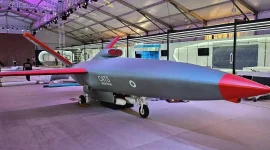
The recent successful ski-jump test of Turkey's Bayraktar TB3 unmanned combat aerial vehicle (UCAV) has sparked discussions about the potential for similar operations with India's Archer UAV. Both drones belong to the Medium-Altitude Long-Endurance (MALE) class, serving reconnaissance and surveillance roles in military applications.
Turkey's achievement demonstrates the feasibility of launching medium-sized drones from aircraft carriers equipped with a Short Take-Off But Arrested Recovery (STOBAR) system. This method utilizes a ski-jump ramp for takeoff, an approach used by carriers lacking the powerful catapults needed for conventional launches.
India's Archer, developed by the Aeronautical Development Establishment (ADE), shares functional and size similarities with the Bayraktar TB3. However, the current Archer variant's 16 horsepower piston engine would be insufficient for carrier takeoffs. Upgrading to a more powerful turbodiesel engine is deemed necessary for carrier operations.
While the Archer consistently achieves a 20,000-foot operational altitude with a design ceiling of 22,000 feet, deployment on Indian Navy carriers might necessitate exceeding 25,000 feet for optimal performance. This would require further modifications to both the engine and potentially the airframe for high-altitude operations.
Bayraktar TB3: A New Era for Drone Warfare
The Bayraktar TB3, a derivative of the renowned Bayraktar TB2, is designed for short-runway operations and features foldable wings. This innovation enables its deployment on vessels like the TCG Anadolu, Turkey's first aircraft carrier and the world's first drone carrier. The TB3 successfully completed four takeoffs from a 12-degree inclined ramp, simulating the ship's deck, during its recent test.The TB3 boasts enhanced capabilities compared to its predecessor, the TB2, which has played significant roles in conflicts in Azerbaijan, Libya, and Ukraine. It's expected to offer increased flight duration, higher altitudes, and greater weapons capacity.
Beyond the TB3, Baykar, the drone's manufacturer, also plans to deploy the Kızılelma, an unmanned fighter jet, on the TCG Anadolu. This jet represents a significant expansion of capabilities, promising increased speed and carrying capacity compared to existing platforms.
The Bayraktar TB3's advancements in communication and control systems enable long-distance operation and enhance its potential in various military scenarios. Baykar, a leading Turkish defense exporter, has secured export deals with 34 countries for its various drone models.
India's Potential Path Forward
Turkey's progress with the Bayraktar TB3 underscores potential avenues for India to integrate the Archer or similar UAVs into its naval operations. Upgrading the Archer's engine and airframe design would be crucial for carrier-based deployments. Success with the Archer program could significantly bolster the Indian Navy's aerial surveillance and reconnaissance capabilities.In conclusion, the successful ski-jump test of Turkey's Bayraktar TB3 has ignited interest in India's Archer UAV, highlighting the potential for similar advancements in carrier-based drone operations. Both drones showcase the evolving landscape of unmanned aerial vehicles and their increasing significance in modern warfare.


